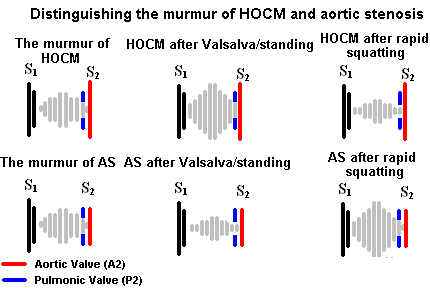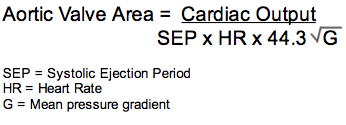Topic Reviews A-Z
Aortic Valve Stenosis Topic Review
Etiology | Symptoms | Physical Examination | Diagnosis | Treatment
RELATED CONTENT: Aortic Stenosis Quiz | Aortic Stenosis Case Questions
Introduction
Aortic stenosis (AS) occurs when the orifice of the aortic valve is significantly reduced due to the failure of the aortic valve leaflets to open fully during systole.
This causes an effective increase in afterload, left ventricular hypertrophy and, eventually, symptoms of congestive heart failure. The classic triad of symptoms from aortic stenosis are angina, syncope and dyspnea. The mortality from aortic stenosis dramatically increases once symptoms develop. No medical therapy exists to halt or reverse the disease process, and aortic valve replacement (AVR) is the ultimate treatment.
Etiology – Aortic Stenosis
The most common cause of aortic stenosis in a person over age 70 years is calcification of a normal trileaflet aortic valve; this process is sometimes referred to as “senile degeneration.” No medical therapy has been shown to delay the valve degeneration. The exact cause of the degeneration is unknown; however, it is speculated that high pressures and turbulence over long periods of time creates an inflammatory state that results in infiltration of macrophages and T lymphocytes and leads to calcification.
The most common cause of aortic stenosis in a person under age 70 years is a congenital bicuspid aortic valve. Approximately 2% of the population is born with a bicuspid aortic valve, and about half of these individuals develop at least mild aortic stenosis by the age of 50 years.
Rheumatic valvular disease is responsible for aortic stenosis on occasion. In this setting, concurrent disease of the mitral valve is almost always present. At least some aortic regurgitation generally accompanies aortic stenosis when rheumatic.
Congenital aortic stenosis results from fusion of the aortic valve leaflets at birth. Sudden death without prior symptoms occurs in about 15% of cases. Balloon valvotomy is the treatment of choice for congenital aortic stenosis, unlike other causes.
Other rare causes of aortic stenosis include inflammatory diseases (i.e. systemic lupus erythematosus or rheumatoid arthritis), severe familial hypercholesterolemia, ochronosis, Paget’s disease of the bone and Fabry’s disease.
Left ventricular outflow obstruction most commonly occurs at the aortic valve itself; however, it can occur above the aortic valve (supravalvular) as in William’s syndrome or below the aortic valve as in hypertrophic obstructive cardiomyopathy (HOCM).
Symptoms – Aortic Stenosis
The classic triad of symptoms of aortic stenosis occur on exertion and include dyspnea, syncope and angina. The development of aortic stenosis takes many years and is initially asymptomatic (latent period). Dyspnea is the first symptom of aortic stenosis in about 50% of the cases; syncope and angina account for 35% and 15% of initial symptoms, respectively.
The clinical significance of a patient with aortic stenosis who exhibits symptoms must not be underemphasized, as the onset of symptoms is accompanied by a dramatic increase in mortality. According to one large series, if aortic valve replacement is not performed, patients presenting with dyspnea have a mean life expectancy of 2 years, those with syncope about 3 years and those with angina an average of 5 years.
Angina in aortic stenosis frequently occurs in the absence of coronary artery disease. Instead, myocardial ischemia and angina develop when the oxygen demand of the severely hypertrophied left ventricle exceeds oxygen supply. It is helpful to know the Law of LaPlace, which explains the phenomenon.
Note: LV wall stress is directly proportional to myocardial O2 demand or, more specifically, O2 demand = wall stress X HR.
Using the above equation, we can understand the pathologic process that develops over many years in patients with aortic stenosis. As LV pressure slowly increases over time due to worsening aortic stenosis, a parallel increase in LV wall thickness (concentric hypertrophy) occurs to maintain the LV wall stress at a constant level; as discussed, LV wall stress is an important determinant of myocardial O2 demand. Eventually, the left ventricle (LV) is unable to hypertrophy any further, but the LV pressure continues to rise as the aortic stenosis worsens. This leads to a rise in LV wall stress, and thus a rise in LV myocardial oxygen demand. When the heart rate increases in response to exertion, a significant supply vs. demand mismatch occurs, resulting in myocardial ischemia and the clinical symptoms of angina; heart rate is also a determinant of O2 demand.
Syncope on exertion, or effort syncope, occurs in aortic stenosis due to a sudden decrease in cerebral perfusion with physical activity. During exercise, the total peripheral resistance (TPR) decreases significantly because blood is being shunted toward working muscles. In the presence of significant aortic stenosis, the cardiac output is unable to increase enough to accommodate this decreased total peripheral resistance (TPR). Hypotension occurs and cerebral perfusion is compromised, resulting in syncope. This idea can be further reinforced by the following equation:
MAP = CO X TPR
MAP = mean arterial pressure CO = cardiac output
If the cardiac output is unable to increase due to severe aortic stenosis, and the TPR decreases during exertion, MAP will subsequently be reduced, leading to decreased cerebral perfusion and syncope.
It is important to note that another cause of syncope in patients with aortic stenosis is arrhythmias, especially atrial fibrillation and AV nodal blocks; this is described later in this section.
Dyspnea on exertion is due to heart failure. Both systolic and diastolic dysfunction typically contributes to heart failure in patients with aortic stenosis. Other classic symptoms of heart failure — orthopnea, paroxysmal nocturnal dyspnea (PND) and signs of right sided heart failure (i.e. peripheral edema) — are also common.
Rare initial symptoms in a patient with aortic stenosis include embolic phenomenon from calcified aortic valve plaques or massive GI bleeding due to angiodysplasia (Heyde’s syndrome). It is believed Heyde’s syndrome is due to disruption of the pentamer structure of the von Willebrand factor as it traverses the severely stenotic aortic valve, leading to increased tendency to bleed from angiodysplasias.
Physical Examination – Aortic Stenosis
Auscultation of the heart in patients with aortic stenosis can be very helpful in both the diagnosis and in determining the severity of disease. The typical murmur of aortic stenosis is a high-pitched, “diamond shaped” crescendo-decrescendo, midsystolic ejection murmur heard best at the right upper sternal border radiating to the neck and carotid arteries (see image below). In mild aortic stenosis, the murmur peaks in early systole. As the disease progresses, the peak moves to later in systole; with longer time required to complete LV systole, aortic valve closure is delayed. The intensity of the murmur typically increases as disease progresses. However, when heart failure develops and cardiac output declines, the murmur becomes softer. Thus, the intensity of the murmur is not a good indicator of disease severity.
Auscultation at the cardiac apex may reveal a murmur that sounds midsystolic or holosystolic and could mimic the murmur of mitral regurgitation. However, this is commonly the result of radiation of the aortic stenosis murmur to the apex rather than coexistent mitral regurgitation. This finding is referred to as “Gallavardin dissociation.” To determine if the apical murmur is indeed due to mitral regurgitation or radiation of the murmur of aortic stenosis, dynamic auscultation can be undertaken (see section on dynamic auscultation).
The murmur of hypertrophic cardiomyopathy can also at times mimic the murmur of aortic stenosis. The Valsalva maneuver decreases the aortic stenosis murmur while it increases the hypertrophic cardiomyopathy murmur.
The S2 heart sound is often paradoxically split in patients with aortic stenosis, though the splitting disappears on inspiration. The split is due to the significantly delayed closure of the aortic valve resulting from the increased time needed to complete LV systole; for more on splitting of S2, see Heart Sounds Topic Review.
As disease progresses and the aortic valve leaflets lose their mobility, the intensity of S2 decreases. When the S2 sound is no longer audible, it can be concluded that the aortic stenosis is relatively severe. A S4 heart sound is also often present due to the severe concentric left ventricular hypertrophy that develops in aortic stenosis. If a S3 heart sound is present, significant systolic dysfunction has developed; this is common in end-stage aortic stenosis.
Perhaps the best bedside method to estimate aortic stenosis severity is derived from evaluation of the carotid arteries. The phenomenon known as pulsus parvus et tardus refers to a weak (parvus) and delayed (tardus) carotid upstroke.
To asses for parvus, it is often helpful to palpate one’s own carotid artery while concurrently palpating the patient’s carotid artery. It is important to note that in some elderly individuals, the carotids may be stiff due to calcification, which may falsely normalize the carotid upstroke.
To assess for tardus, auscultate the patient’s S2 heart sound while palpating their carotid upstroke. The S2 and carotid upstroke should occur almost simultaneously. If the carotid upstroke comes significantly after the S2 heart sound, tardus is present — indicating severe aortic stenosis.
Other physical exam findings in patients with aortic stenosis include those of both right and left heart failure.
Diagnosis – Aortic Stenosis
The diagnosis of aortic stenosis is made mostly on physical examination and by echocardiography. The ECG in patients with aortic stenosis frequently shows left ventricular hypertrophy with strain and left atrial enlargement; however, these findings are non-specific for aortic stenosis.
The echocardiogram can also quantify aortic stenosis severity. Two-dimensional echocardiography can demonstrate a thickened aortic valve, reduced leaflet mobility and concentric left ventricular hypertrophy.
The severity of aortic stenosis is determined by measuring the aortic valve area (AVA) and calculating the pressure gradient between the left ventricle and the aorta on echocardiography. Aortic stenosis is described as mild, moderate, severe or critical based on these measurements.
The velocity of blood flow across the aortic valve, as determined by continuous wave Doppler, is used to calculate the transaortic pressure gradient using the modified Bernoulli equation:
Pressure gradient = 4v2
v = velocity
The AVA is calculated using the continuity equation:
A1 X V1 = A2 X V2
A2 = (A1 X V1) / V2
Where A1 is the area of the left ventricular outflow tract, V1 is the velocity of flow at the left ventricular outflow tract, A2 is the area of the aortic valve and V2 is the velocity of flow at the aortic valve. All of the above except A2 can be directly by 2D echocardiography (LV outflow tract area) or measured using continuous wave (CW) Doppler. The AVA is then calculated as shown above.
The chest radiography may reveal a normal cardiac size since the hypertrophy in aortic stenosis is concentric; however, once LV systolic failure occurs, cardiomegaly will be seen. Calcification of the aortic valve, pulmonary congestion, and post-stenotic dilation of the aorta are other non-specific findings.
| Mean gradient (mmHg) | Aortic Valve Area (cm2) | |
| Mild | 15-25 | > 1.5 |
| Moderate | 25-40 | 1.0-1.5 |
| Severe | > 40 | 0.7-1.0 |
| Critical | N/A | < 0.7 |
Cardiac catheterization is indicated when the angina of aortic stenosis may be due to coexistent coronary disease or when aortic valve replacement is indicated. Rarely, catheterization with crossing of the aortic valve for hemodynamic measurements may be needed if echocardiography is unable to determine if severe aortic stenosis is present.
During cardiac catheterization, the pressure gradient is found by using the catheter to measure the pressure in the aorta, then advancing it into the LV and taking another pressure reading. The difference between these two pressures is the pressure gradient. The cardiac output and pressure gradient are directly measured and used to calculate the AVA using the Gorlin equation below.
The mean transaortic valve pressure gradient is used in the Gorlin equation to calculate the AVA, not the peak gradient. The cardiac output is calculated using either the Fick principle or the indicator-dilution principle. It is important to note that the Gorlin formula was originally derived using patients with mitral stenosis and not aortic stenosis. The Gorlin equation is also flow-dependent; thus, if the patient has a significantly decreased ejection fraction, the AVA may be underestimated.
Note that if the left ventricular systolic function is poor from another cause (i.e. ejection fraction of < 30% from a prior MI), the cardiac output may be so low that a significant pressure gradient is not able to be physiologically achieved. Severe aortic stenosis can be present even if the mean pressure gradient is < 40 mmHg in this setting. This is called “low-flow, low-gradient” aortic stenosis. Dobutamine stress echocardiography can help determine if truly severe aortic stenosis is present (with a falsly low gradient) or if mild/moderate aortic stenosis is present.
Treatment – Aortic Stenosis
The only effective treatment for aortic stenosis is removal of the mechanical obstruction. To this end, only aortic valve replacement (AVR) has been shown to achieve this while reducing mortality. aortic valve replacement (AVR). Transcatheter aortic valve replacement is now FDA approved for those patients who are not surgical candidates due to age and comorbid medical conditions and is being performed successfully in many major medical centers. Aortic valve debridement via surgery or ultrasound debridement is a poor alternative to AVR. High rates or aortic regurgitation occur with these procedures and the aortic stenosis may recur in a large percentage of patients.
Pharmacological therapy is in general not effective in aortic stenosis. In fact, in critical aortic stenosis, many of the standard cardiovascular medications such as ACE inhibitors and beta blockers are considered to be relatively contraindicated when hypotension is present from low cardiac output.
Aortic balloon valvuloplasty is very beneficial in congenital aortic stenosis where no calcification of the aortic valve has occurred, however, every other type of aortic stenosis is accompanied by significant calcification and this modality is generally not effective. In adults with aortic stenosis undergoing valvuloplasty, severe aortic stenosis returns at 6 months in about 50% of cases. valvuloplasty does not result in regression of left ventricular hypertrophy. In fact, at 6 months after valvuloplasty about 50% of patients have completely restenosed their aortic valve to the same extent as before the procedure. The procedural mortality rate is 2-5%, similar to that of surgical AVR.
In addition, long term studies have shown that the overall mortality of patients undergoing valvuloplasty for aortic stenosis is the same as if they did not have the procedure at all. Therefore, the role of valvuloplasty is limited to palliative treatment of severe aortic stenosis or as a bridge to AVR in patients who are unable to immediately undergo a major surgery.
Surgical AVR is the definitive treatment for all types of aortic stenosis excluding congenital aortic stenosis. Any patient who is symptomatic from aortic stenosis should undergo AVR as soon as possible.
AVR is generally not indicated if asymptomatic unless echocardiographic surveillance reveals rapidly progressing aortic stenosis with LV dysfunction or severe calcification of the aortic valve. Even in patients with critical aortic stenosis, AVR is still beneficial and age is never considered a contraindication to surgery. The ejection fraction may double or even return to normal and the LVH frequently regresses. It is rarely ever considered too late to replace the aortic valve in patients with critical aortic stenosis unless coexisting conditions increase the risk of surgery.
A good approach to aortic stenosis is to follow regular echocardiograms and if the mean pressure gradient is > 25 mmHg, repeat the history and physical every 6 months and instruct the patient to notify their physician if any signs or symptoms of aortic stenosis develop.
In general, patients with a low transaortic valve gradient of less than 25 mmHg and advanced heart failure do not improve after AVR. It is thought that in this subgroup irreversible myocardial remodeling has already occurred. However, a minority of these patients do improve significantly after AVR, so the risks of no improvement must be discussed with these patients before AVR is undertaken.
References:
Carabello, BA. Aortic Stenosis. N Engl J Med 2002; 346:677-682.
ACC/AHA Guidelines: Valvular Heart Disease
Braunwald's Heart Disease: A Textbook of Cardiovascular Medicine
Hurst's the Heart, 13th Edition
Image Reference: CC Patrick J. Lynch and C. Carl Jaffe, Yale University, 2006







